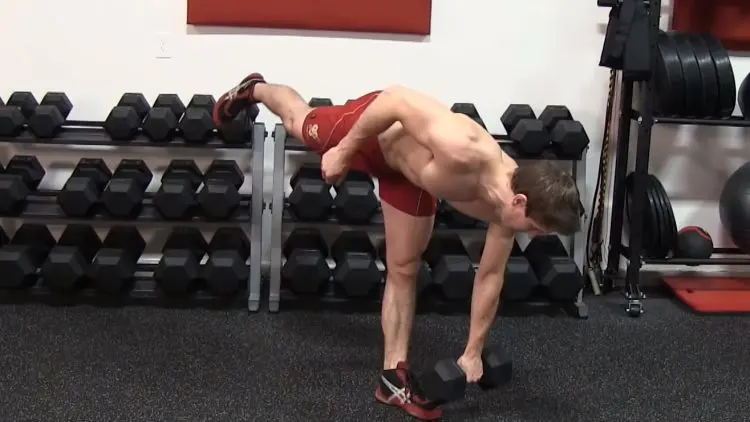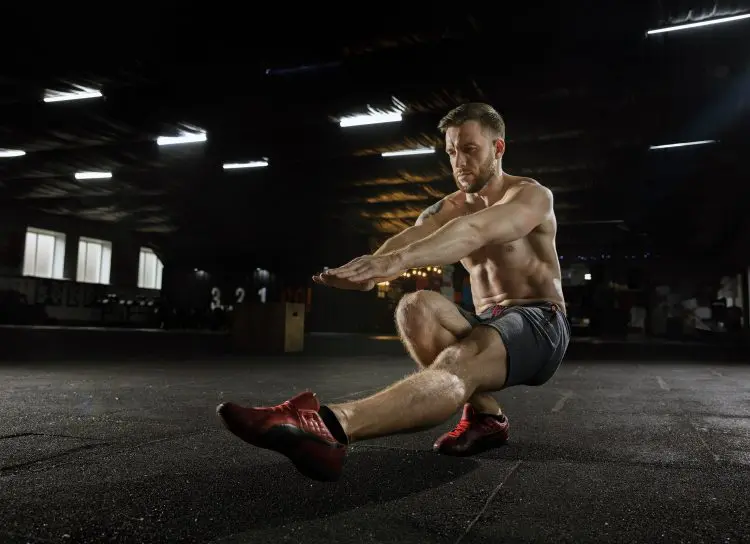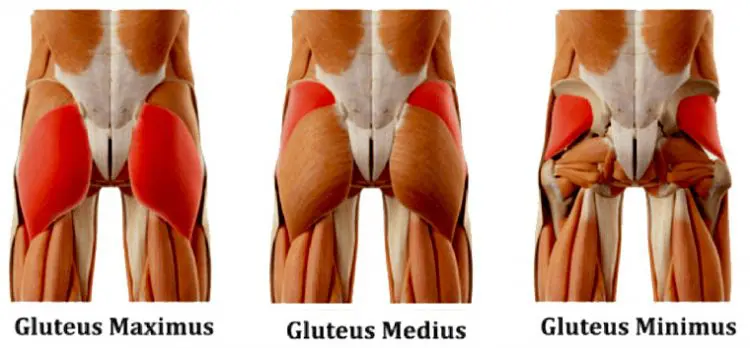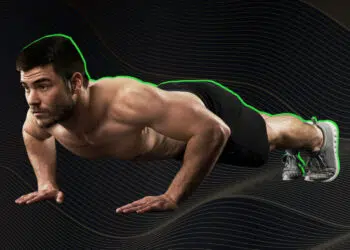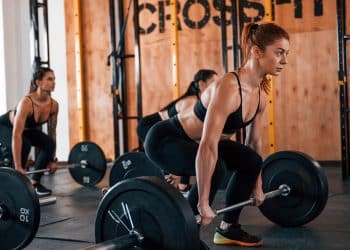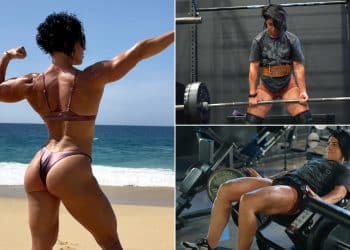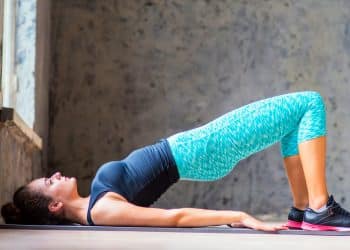Contrary to what Instagram fitness models would have you believe, your butt is not a single muscle. Squatting every day alone won’t help you get the pear-shaped rear you’ve always wanted. So, step out of the squat rack and hear me out. What you learn today will help put a dent in your butt — literally.
It would be safe to categorize booty enthusiasts into two categories. First, the ‘Physical’ series inspired head-band-wearing group workout junkies. Second, the squat fanatics. While I have nothing against either, both these groups leave gains on the table by sticking to a cult.
As a personal trainer with over 17 years of experience, I can attest that you must pay equal attention to the gluteus maximus, minimus, and medius to improve overall strength, muscle mass, and functionality.
In this article, I reveal the 13 best gluteus medius exercises you must perform to transform your derriere.
Recent Updates: On July 9, 2024, Fitness Volt’s Senior Editor Vidur Saini (American Council on Exercise-CPT) updated the article and added actionable expert tips throughout the piece to improve the reader experience. Level Up Your Fitness: Join our 💪 strong community in Fitness Volt Newsletter. Get daily inspiration, expert-backed workouts, nutrition tips, the latest in strength sports, and the support you need to reach your goals. Subscribe for free!
Top 13 Exercises For Building Solid Gluteus Medius
Add the following lifts to your exercise arsenal:
- Frog Pump
- Lateral Step-Up
- Banded Barbell Hip Thrust
- Single-Leg Deadlift
- Isometric Single-Leg Wall Lean
- Banded Clamshell
- Front Plank With Hip Extension
- Banded Monster Walk
- Lateral Band Walk
- Side-Lying Abduction
- Side Plank With Abduction
- Single-Leg Squat
- Single-Leg Wall Sit
Weighted Exercises:
1. Frog Pump
| Sets & Reps | Equipment Needed | Target Muscles |
| 3 x 10-15 (Hypertrophy) | None (Bodyweight) | Gluteus maximus, medius, adductors, hamstrings |
With every gluteus medius exercise, you need to target the outside of your butts. Contract the butt at the top of the movement to make the most of the exercises.
Saini says the frog pump is a fantastic glute activator, particularly for individuals who struggle to feel their glutes working in other exercises.
Steps:
- Lay down with your back on an exercise mat.
- Fold your knees so that you can put the soles of your feet together.
- Place a dumbbell a little above your groin and grab it with both your hands.
- Thrust your hips explosively while driving the sides of your feet into the ground.
- Contract your glutes at the top of the movement.
- Return to the starting position and repeat for reps.
- This exercise should feel like a mix of clamshells and hip thrusts.
Pro Tip: The gluteus medius exercises are all about adductions. Using a resistance band around your knees can improve your side glute recruitment as it puts constant tension on the muscles.
| Difficulty | Progression | Regression |
| Beginner | Elevated frog pump (feet on bench), weighted frog pump | Reduce range of motion, glute bridge |
2. Lateral Step-Up
| Sets & Reps | Equipment Needed | Target Muscles |
| 3 x 8-12 per leg (Hypertrophy); 3 x 5-6 per leg (Strength) | Box or bench | Quadriceps, gluteus medius, and minimus, hamstrings |
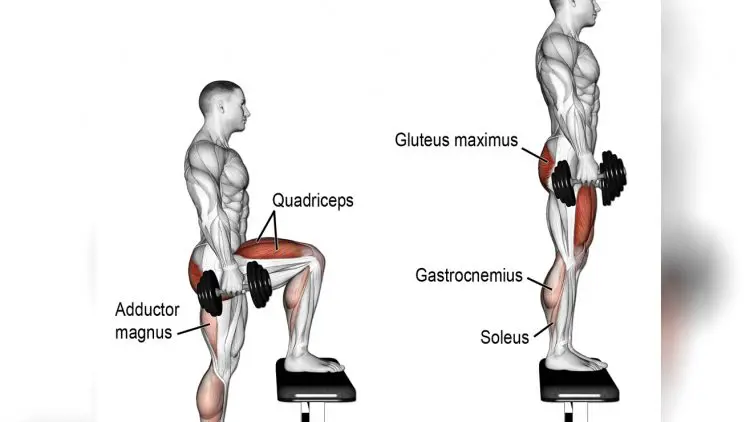
Per Saini, you are doing the exercise incorrectly if you don’t feel a sick pump in your side glutes after any of the exercises mentioned in this list. Drop your ego, lighten the weights, and go at it again.
Steps:
- Grab a dumbbell in each hand and stand next to an elevated surface with your side body facing it.
- Lift the foot closest to the platform and place it on top.
- Using the raised leg, with minimal assistance from the other, push through the whole foot to lift yourself to a standing position on the box.
- Step back down into the starting position.
- Repeat for recommended reps.
- Switch sides and repeat.
Pro Tip: Maintain a tall posture with your chest lifted throughout the movement. This will prevent excessive forward lean and ensure proper engagement of the glutes and quads.
| Difficulty | Progression | Regression |
| Beginner | Increase box height, add weight (dumbbells or barbell) | Use a smaller box, assisted step-up |
3. Banded Barbell Hip Thrust
| Sets & Reps | Equipment Needed | Target Muscles |
| 3 x 8-12 (Hypertrophy); 3 x 5-6 (Strength) | Barbell, weights, resistance band | Gluteus maximus, medius hamstrings, core |
The glutes are the most powerful muscles in your body. They will jump in to assist you whenever you perform an exercise that engages the lower body. Going too heavy on exercises on this list will engage the gluteus maximus and leave the medius in limbo.
Focus on performing the exercise with the correct form and contract the side glutes with each rep. Weights can come later.
Steps:
- Sit with your back placed against a flat bench.
- Bend at your knees so that your feet are planted flat on the floor.
- Place a band around your knees and a barbell across your hips.
- Squeeze the glutes and thrust the bar straight up until your hips are in line with the shoulder and knees.
- Slowly return to the starting position and repeat for reps.
Pro Tip: Adding a band to the barbell hip thrust increases tension at the top of the movement, leading to greater glute activation and hypertrophy.
| Difficulty | Progression | Regression |
| Intermediate | Increase weight, use heavier band, single-leg hip thrust | Bodyweight hip thrust, banded glute bridge |
4. Single-Leg Deadlift
| Sets & Reps | Equipment Needed | Target Muscles |
| 3 x 8-12 per leg (Hypertrophy); 3 x 5-6 per leg (Strength) | Dumbbell or kettlebell (optional) | Hamstrings, gluteus maximus, medius, erector spinae, core |
Single-leg exercises are incredibly effective at building the side butt. They also help build your core strength and stability. You should have at least one single-leg exercise in your glute workout.
Saini recommends beginners hold onto a sturdy object with the non-working hand for balance and stability.
Steps:
- Grab a dumbbell in each hand with a neutral grip (palms facing each other).
- Stand with a shoulder-wide stance, pin back your shoulders and push your chest out.
- Slightly bend your left knee and lift it off the floor.
- Find a stable starting position.
- Slowly push your left leg back and let your torso come forward.
- Maintain a tight core throughout the exercise.
- Go as low as you can without losing balance.
- Return to the starting position and repeat for reps before switching sides.
Pro Tip: In this hip hinge exercise, keep your back flat and focus on pushing your hips back rather than lowering your chest toward the ground.
| Difficulty | Progression | Regression |
| Intermediate | Increase weight, use heavier band, single-leg hip thrust | Bodyweight hip thrust, banded glute bridge |
Bodyweight Exercises:
5. Isometric Single-Leg Wall Lean
| Sets & Reps | Equipment Needed | Target Muscles |
| 3 x 30-60 seconds per leg | Wall | Gluteus medius, core |
You don’t need to use a ton of weight to train your gluteus medius effectively. Hell, you could pump your side butt with blood and lactic acids with bodyweight and isometric exercises alone.
The isometric hold in this exercise helps build gluteus medius endurance, which is important for maintaining proper hip alignment and preventing knee pain.
Steps:
- Stand next to a wall with your side body facing it.
- Lift the leg closest to the wall until your upper leg is parallel to the floor.
- Press the foot of the other leg into the floor while driving the elevated leg into the wall.
- The gluteus medius of the planted leg will kick in to stabilize the pelvis.
Pro Tip: Engage your core throughout the hold to maintain proper spinal alignment. This will increase the challenge to your glutes and protect your lower back from unnecessary strain.
| Difficulty | Progression | Regression |
| Beginner | Increase hold time, perform on an unstable surface | Double-leg wall lean |
6. Banded Clamshell
| Sets & Reps | Equipment Needed | Target Muscles |
| 3 x 15-20 per leg | Resistance band | Gluteus medius, gluteus minimus |
The banded clamshell is a simple yet effective exercise for targeting the often-neglected gluteus medius, a muscle that plays a key role in hip stability and movement.
Clamshells are one of the most effective exercises for building the gluteus medius. Remember: Your focus should be on contracting the side butt with every rep.
Steps:
- Lie on your side with legs stacked, and knees bent at a 45-degree angle.
- Place a resistance band around your knees.
- Rest your head on your lower arm, and place your top arm on your waist.
- Brace your core as it will help stabilize your spine and pelvis.
- While keeping your feet touching, raise your upper knee as high as you can without shifting your hips or pelvis.
- Pause and contract your glutes at the top of the movement.
- Return to the starting position and repeat before switching sides.
Pro Tip: To intensify the burn, pause briefly at the top of each rep, squeezing your glutes and external rotators for a few seconds before returning to the starting position.
| Difficulty | Progression | Regression |
| Beginner | Use a heavier band, hip abduction machine | Clamshell without band, side-lying leg raise |
7. Front Plank With Hip Extension
| Sets & Reps | Equipment Needed | Target Muscles |
| 3 x 8-12 per leg (Hypertrophy); 3 x 5-6 per leg (Strength) | None (Bodyweight) | Gluteus maximus, medius, core |
This exercise combines core stability with glute activation, making it a great option for improving overall athleticism and functional movement.
Steps:
- Get into a planking position.
- Lift one leg off the floor while maintaining a slight bend in the knee.
- Try to pull your elevated leg past parallel without extending at the hips.
- Hold and contract at the top.
- Return to the starting position with a controlled motion and repeat for reps.
Pro Tip: Maintain a neutral spine throughout the movement. Avoid arching your back or dropping your hips as you lift your leg. This will ensure proper core engagement and protect your lower back.
| Difficulty | Progression | Regression |
| Intermediate | Hip extension with resistance band, single-leg plank with hip extension | Front plank, bird dog |
8. Banded Monster Walk
| Sets & Reps | Equipment Needed | Target Muscles |
| 3 x 10-15 steps per direction | Resistance band | Gluteus medius, gluteus minimus, hip abductors |
The banded monster walk is a low-impact exercise that can be easily modified to increase or decrease resistance, making it suitable for varying fitness levels.
Steps:
- Place a resistance band around the knees or shins.
- Assume a quarter-squat position.
- While maintaining the squat, step forward diagonally as if walking.
- Walk back to the starting position.
Pro Tip: Keep tension on the band throughout the entire exercise to ensure continuous engagement of the glutes and hip abductors, leading to greater muscle activation and growth.
| Difficulty | Progression | Regression |
| Beginner | Use a heavier band | Monster walk without a band, standing hip abduction |
9. Lateral Band Walk
| Sets & Reps | Equipment Needed | Target Muscles |
| 3 x 10-15 steps per direction | Resistance band | Gluteus medius, gluteus minimus, hip abductors |
This exercise is a great way to warm up the hips and glutes before a workout and strengthen the muscles that help stabilize the knee.
Level Up Your Fitness: Join our 💪 strong community in Fitness Volt Newsletter. Get daily inspiration, expert-backed workouts, nutrition tips, the latest in strength sports, and the support you need to reach your goals. Subscribe for free!
Steps:
- Place a resistance band around your knees or shins.
- Assume a quarter-squat stance.
- Maintain the squat position while stepping laterally.
- Take wide enough steps so that there is constant tension on the band.
Pro Tip: Avoid leaning forward or backward as you step laterally. Maintain a tall posture and keep your core engaged to ensure optimal muscle engagement.
| Difficulty | Progression | Regression |
| Beginner | Use a heavier band | Lateral band walk without a band, standing hip abduction |
10. Side-Lying Abduction
| Sets & Reps | Equipment Needed | Target Muscles |
| 3 x 15-20 per leg | None (Bodyweight) or ankle weights (optional) | Gluteus medius, gluteus minimus, tensor fasciae latae (TFL) |
Side-lying abduction is a versatile exercise that can be done with or without weights, making it a great option for beginners and advanced lifters.
Steps:
- On an exercise mat, lie down on your side.
- Your body should be in a straight line throughout the exercise.
- Place one leg on top of the other.
- Rest your head on your lower arm, and place your top arm on your waist.
- Lift your top leg as high as you can.
- Squeeze your glutes at the top of the movement before returning to the starting position.
- Repeat for the recommended reps.
Pro Tip: To maximize gluteus medius activation, externally rotate your leg slightly before lifting to bias the muscle fibers responsible for hip abduction.
| Difficulty | Progression | Regression |
| Beginner | Add ankle weights, hip abduction machine | Side-lying leg raise |
11. Side Plank With Abduction
| Sets & Reps | Equipment Needed | Target Muscles |
| 3 x 8-12 per leg | None (Bodyweight) | Gluteus medius, gluteus minimus, core |
This challenging exercise strengthens the core and glutes and improves shoulder stability and overall body control.
Steps:
- Lay down on an exercise mat with your right elbow and leg on the ground.
- Lift your body into a side plank position. Your body should be in a straight line at the start of the exercise.
- Your right elbow should be under your right shoulder, and the lower arm should be perpendicular to your torso.
- Raise your top leg as far as you can and contract your side butt at the top.
- Return to the starting position and repeat for reps.
Pro Tip: Maintain a straight line from your head to your heels throughout the movement for optimal core engagement and to protect your spine from unnecessary stress.
| Difficulty | Progression | Regression |
| Intermediate | Side plank with a resistance band, side plank with leg raise, and hold | Side plank, modified side plank |
12. Single-Leg Squat
| Sets & Reps | Equipment Needed | Target Muscles |
| 3 x 8-12 per leg (Hypertrophy); 3 x 5-6 per leg (Strength) | None (Bodyweight) or Dumbbell (optional) | Quadriceps, gluteus maximus, medius, hamstrings, core |
The last two exercises are arguably the most challenging exercises on the list. But don’t worry, we won’t ask you to perform a single-leg “ass to the grass” squat. You can use a flat bench or an elevated platform to limit your range your motion until you build strength in your legs.
Steps:
- Stand with your back towards an elevated platform.
- Lift your right leg forward and hold it out straight and slightly in front of your torso.
- Extend your arms straight in front of you for balance.
- Perform a squat by bending at your left knee while keeping your torso upright.
- Lower down until you touch the box.
- Squeeze your glutes as you push into the left foot to stand back up.
Pro Tip: Focus on keeping your knee aligned with your toes as you lower yourself. This will prevent excessive inward knee rotation and reduce the risk of injury.
| Difficulty | Progression | Regression |
| Advanced | Pistol squat, weighted pistol squat | Assisted pistol squat, Bulgarian split squat |
13. Single-Leg Wall Sit
| Sets & Reps | Equipment Needed | Target Muscles |
| 3 x 30-60 seconds per leg | Wall | Quadriceps, gluteus medius |
The single-leg wall sit is an isometric exercise that helps to build endurance in the quadriceps and glutes, which is important for running, jumping, and other athletic activities.
Steps:
- Stand with your back against a wall.
- Lift your right leg forward and hold it out straight and slightly in front of your torso.
- Slide your back down the wall until your upper legs are parallel to the floor.
- Squeeze your glutes and return to the starting position.
- Your planted lower leg should be parallel to the wall at all times.
- The knee of your planted leg should not extend beyond your toes at any point throughout the exercise.
Pro Tip: Engage your core muscles to maintain proper spinal alignment and avoid leaning forward. This will increase the challenge to your quadriceps and glutes and protect your lower back from strain.
| Difficulty | Progression | Regression |
| Beginner | Increase hold time, perform with a raised heel | Double-leg wall sit |
Gluteal Anatomy
Glutes consist of three muscles:
- Maximus
- Medius
- Minimus
If you are hearing about these three muscles for the first time:
First – you are not alone.
Second – you’re welcome.
Gluteus Maximus: When you check out your butt in the mirror, you are staring at the gluteus maximus. It is the largest gluteus muscle and does most of the heavy lifting.
Gluteus Minimus: We did an article on gluteus minimus and everything you should know about it. It is the smallest butt muscle and lies beneath the gluteus maximus, medius, and tensor fasciae latae.
Read Also: Gluteus Minimus Exercises For Rounder Hips & a Jaw-Dropping Side Butt
Gluteus Medius: If you want to make the Kardashian’s envy your booty, working on all three gluteus muscles is non-negotiable. Add all exercises mentioned below and in the gluteus minimus article to your arsenal.
Hello, Gluteus Medius!
The gluteus medius is a broad, thick, and radiating muscle. The giant fan-shaped muscle is located in the posterior hip, extending from the ilium (the largest part of the hip bone) to the proximal femur. It is the muscle you are touching when you run your hands down the sides of your rear.
Gluteus Medius Insertion
Like the shoulder joint, the gluteus medius is divided into three portions:
- Muscle fibers of the posterior portion pass forward and downward.
- Fibers of the middle portion pass downward.
- Fibers of the anterior pass backward and downward.
All these fibers combine to form a flattened tendon that is then inserted into the greater trochanter of the femur (the big knob at the end of the thigh bone).
The overpowering big brother, gluteus maximus, covers two-thirds of the darling gluteus medius. Anterosuperior (forward-upper) fibers of the medius are the only portion that has a life of their own.
Functions of Gluteus Medius
1. Hip Abduction
The gluteus medius is the primary hip abductor. The anterior fibers help with internal rotation of the thigh, while the posterior help with lateral rotation when the knee is in extension.
2. Assists in Flexion and Extension
Flexion occurs when the thighs are raised until your upper legs are parallel to the floor or when your torso is bent down. Hip flexion causes closure of the hip joint. On the other hand, hip extension is the opening of the hip joint.
3. Maintains Hip Level
If it were not for the gluteus medius, you would walk like a Victoria’s Secret model trying too hard. The medius acts from the femur to stabilize the pelvis and maintains the trunk upright when standing on one leg, running, and walking when one leg is off the ground.
The gluteus medius and minimus prevent the pelvis from sagging downwards on the unsupported side by applying traction on the hip bone.
4. Rotations
The gluteus medius helps with the internal (anterior portion) and external (posterior) rotation of the hip. In internal rotation, the legs are turned inwards. External rotations transpire when your hips are rotated outwards.
5. Maintains Frontal Plane Stability
A strong gluteus medius is crucial for maintaining frontal plane stability of the pelvis. If you feel like a deer caught in the headlights reading about the three planes of motion, we highly recommend reading this article.
Sabotaging Gluteus Medius
Sometimes knowing what not to do can do you better than knowing what you should do. You can save yourself a lot of trouble by avoiding the following gluteus medius-wrecking mistakes:
1. Standing with bodyweight shifted mainly on one limb can cause hip joint adduction and the pelvis to sway sideways. Maintaining this position for an extended period can lengthen the gluteus medius muscles which can, in turn, reduce hip stability and cause lower back pain. Be mindful of your posture at all times before a bad habit starts creating issues.
2. Sitting crossed-legged for long periods can weaken the hip abductor muscles by putting the muscle in an elongated position. If you prefer sitting with your legs crossed, make sure you are switching the top leg often.
3. Sleeping on your sides without a pillow under your top leg can lead to the top leg flexed and adducted over the lower leg. Staying in this position for 2-4 hours on a stretch every night can compound your problems quickly.
Research has found that sleeping in nonsymmetrical postures can cause negative structural changes to your spine. Using a pillow between your legs to improve your sleeping posture can help maintain spinal health and overall posture.
Conclusion
For the overall development of your glutes, you need to think beyond squats. Design your glute workouts around the three gluteal muscles.
People train their anterior, medial, and posterior deltoids, and even the inner, medial and outer quad sweep, but they don’t follow the same approach for the glutes.
Remember: The goal with these exercises is to contract the side glutes with every rep. If you feel a pump in the gluteus maximus, you should lower the weights and increase the TuT (time under tension) for a muscle ripping pump in the gluteus medius.
Interested in measuring your progress? Check out our strength standards for Hip Abduction, Bulgarian Split Squat, Deadlift, and more.

